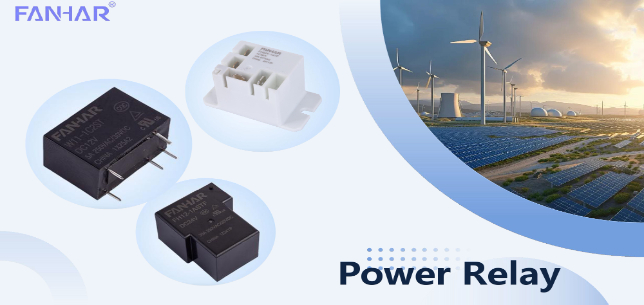
1. What is a Power Relay?
A power relay is an electric device used in the switching of high power currents with the help of electrical signals. Conversion of a low-voltage input signal into high-current output is based on electromagnetic principles, finding broad applications in power systems, industrial automation, electrical equipment, and many others.Power relays guarantee electrical safety, exact control, and remote operation of an apparatus in power systems.
2. Their importance in power systems
In power systems, relays not only execute an automatic control function but also play a very important role in equipment protection, such as rapid disconnection of the circuit in abnormal conditions. Their reliability and stability are very important to ensure normal operation in power equipment.
Power relays are widely used for the control of equipment such as motors, transformers, power switches, and so on, and can provide real-time monitoring and protection of the power system.
1. Safety operation regulations for general-purpose relays
The following are some basic principles of safe operation to be observed in using power relays:
Provide for disconnected operation: The power supply should be disconnected every time during the installation or servicing of relays. This will prevent the risk of electric shock.
Avoid overloading: The rated voltage and current of the relay should be matched to the load to avoid damage to the relay due to overloading.
Use suitable environment: Ensure the relay operates in a clean, dry and well-ventilated environment to avoid high humidity or corrosive gases affecting the relay performance.
Regular Inspection: Regularly inspect the contacts and housing of the relay to remove dust and dirt in time to ensure its proper operation.
2. How to install the relay correctly to prolong its life?
The installation of the relay is the key to ensure its long-term stable operation. Correct installation includes:
Choose the appropriate mounting location: it should be suitable for the working environment of the relay, avoiding high temperatures, strong electromagnetic interference, or humid conditions.
Ensure proper cable connection: the cables must be firmly attached to ensure good contact, preventing loose connections that could cause the relay to fail.
Heat Dissipation: Allow space for the relay to release the heat produced by its operation, as a small place limits heat dissipation, thereby reducing the lifespan through burning due to excessive heat.
Take all the protection measures that include the use of fuses and overload protection to avoid electric shocks to the relay.
1. Procedure for testing relays with a multimeter
Regularly inspecting the performance of relays is essential for ensuring their proper functioning. A multimeter can be used to test the electrical performance of the relay.
Check Coil Resistance: Set the multimeter to measure resistance and test the relay coil’s resistance to verify that it falls within the normal range.
Check contact closure status: When the relay is absorbed, use the multimeter to check whether the contacts are closed normally (normally open contacts should be closed and normally closed contacts should be open).
Test load connection: Connect the load and power on the relay to check whether the working status of the relay is stable.
2. Importance of regular inspection and cleaning of relays
The contacts of the relay may accumulate dust, dirt or be oxidised due to long-term use, affecting its performance. Regular inspection and cleaning of the relay can effectively extend its service life and maintain the sensitivity and reliability of the relay. When cleaning, use a clean, soft cloth and avoid the use of highly corrosive cleaners or tools.
1. Advantages and disadvantages of different contact materials
Material directly defines both performance and service life of the relays. Among many, common relay contact materials include but are not limited to silver, gold, copper, etc. All of them have certain strong and weak points:
Silver alloy: it demonstrates excellent conductivity, is very durable, yet in high-frequency applications with low current usage, it may be prone to oxidation.
Gold contacts: Gold has excellent corrosion resistance and conductivity and is suitable for low-current, high-frequency applications, but is more costly.
Copper Contacts: Copper has good conductivity, but is prone to oxidation in high temperature environments and is suitable for high power current applications.
2. How to choose the suitable contact material for the application?
The following factors must be considered when selecting an appropriate contact material:
Operating Current and Voltage: For applications involving high current and voltage, silver alloy or copper contacts should be chosen to ensure a longer service life.
Environmental Factors: Gold contacts are a better option in humid and corrosive environments because they can effectively prevent oxidation.
Frequency Requirements: For high-frequency applications, gold contacts are more suitable due to their superior electrical contact properties.
1. Prospects for application in the field of new energy vehicles
With the development of new energy vehicle industry, the demand for power relays is growing rapidly. The battery management system, charging piles, and power systems of electric vehicles all require high-performance power relays for control and protection.
In the future, power relays will operate in higher voltage and current environments, so the requirements for their reliability, durability and intelligence will be higher.
2. How can relay technology support sustainable energy development?
Power relays are becoming increasingly important in the field of sustainable energy. They are widely used in energy management and regulation in solar, wind, and energy storage systems. As the global energy transition advances, relay technology will be an important component in supporting green energy development. By improving the efficiency of relays, reducing power consumption, and promoting the application of intelligent and digital technologies, power relays can better serve the sustainable energy sector.
Power relays play an indispensable role in modern power systems, from the protection of electrical equipment to automation control, their role is irreplaceable. Through proper use and regular maintenance, the service life of relays can be extended to ensure the stable operation of equipment. With the progress of technology, power relays will play a more important role in the fields of new energy vehicles and sustainable energy.